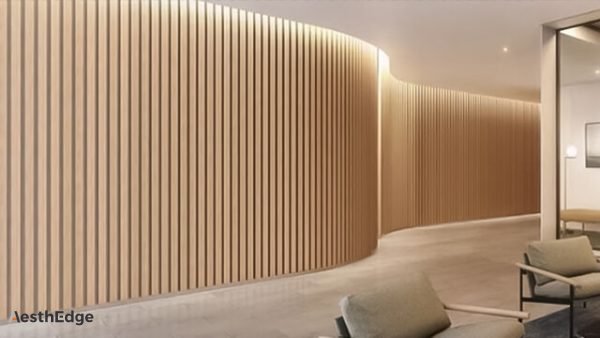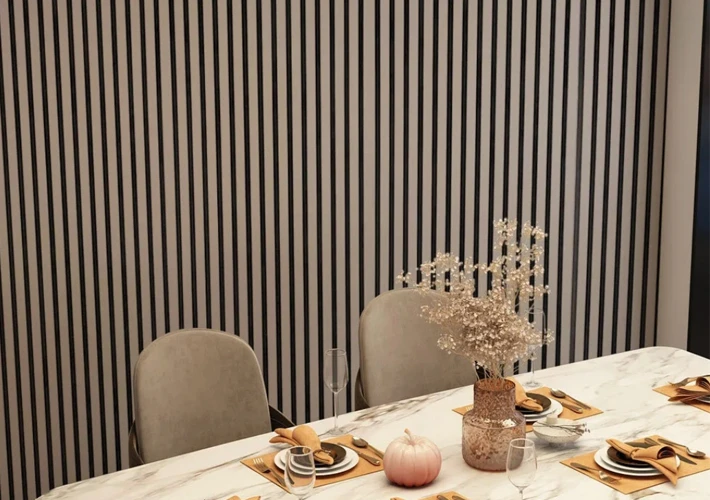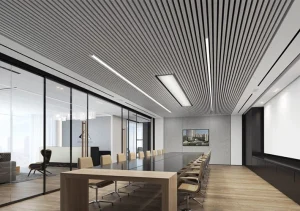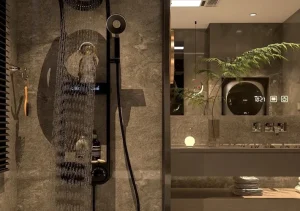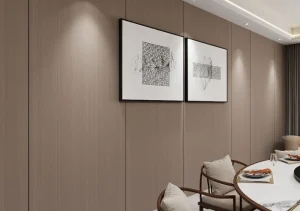Table of Contents
ToggleIntroduction: Elevating Living Room Design with Wooden Wall Panels
In today’s interior design world, homeowners and designers alike are seeking ways to combine warmth, texture, and modern sophistication in their living spaces. One of the most effective and elegant solutions is the wooden wall panel. These panels not only transform the visual appeal of a living room but also offer practical benefits such as sound insulation, durability, and easy maintenance.
Whether you’re designing a luxury villa, a cozy apartment, or a commercial lounge area, wood wall panels bring a sense of timeless elegance and natural charm that few other materials can match. In this article, we’ll explore how wooden wall panels can transform your living room, the different types and styles, installation ideas, and why choosing a reliable manufacturer or supplier matters for long-term satisfaction and business success.
The Aesthetic Power of Wooden Wall Panels
1.1 Adding Warmth and Character
Wood has a natural warmth that instantly makes a space feel inviting. Unlike painted drywall or wallpaper, wooden wall panels create depth and texture, transforming a plain living room into a luxurious retreat. The wood grain, natural variations, and tones make every panel unique, reflecting craftsmanship and authenticity.
Designers often use wooden panels to:
- Create accent walls behind sofas or TVs
- Add rustic or modern contrast to minimalist spaces
- Highlight architectural elements like columns or niches
Whether you prefer dark walnut tones for a rich, dramatic ambiance or light oak for a Scandinavian minimalist look, wood panels can match any interior design style.
1.2 Blending Tradition with Modern Design
Modern interior design trends focus on the fusion of natural elements with contemporary aesthetics. Wooden wall panels can easily blend into:
- Modern minimalist interiors with sleek vertical slats or geometric panels
- Classic or vintage interiors using carved or traditional wood grains
- Eco-friendly, sustainable designs made from recycled or engineered wood
This versatility makes wooden panels a top choice for architects and designers working on both residential and commercial projects.
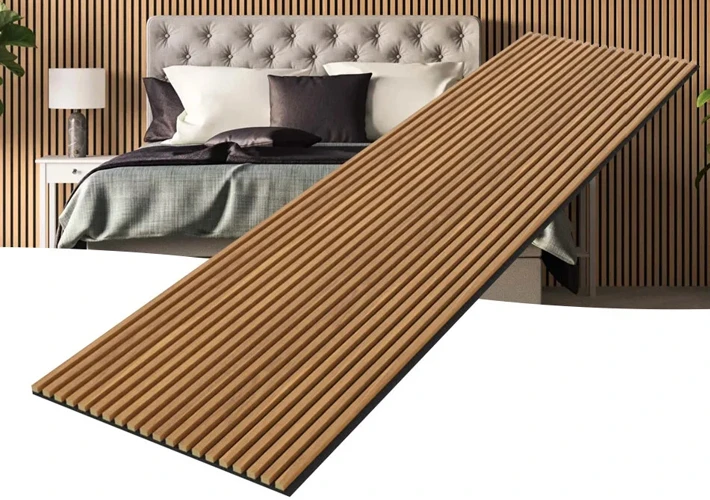
Functional Advantages of Wooden Wall Panels
2.1 Superior Sound Insulation
One of the biggest advantages of wood wall panels is their sound-absorbing capability. In a living room, especially with large TVs, music systems, or open layouts, echo and noise can become a problem.
Wooden panels—particularly acoustic slat wood panels—can effectively reduce sound reflection, creating a quieter, more comfortable environment.
Many modern panels come with felt backings made from recycled PET material, providing both eco-friendliness and acoustic performance. This is why wooden acoustic panels are increasingly popular not only for homes but also for offices, hotels, and studios.
2.2 Thermal Insulation
Wood is a natural insulator. Installing wood panels helps maintain room temperature by adding an extra layer between the wall and indoor space. This not only enhances comfort but can also reduce heating and cooling costs.
2.3 Durability and Easy Maintenance
High-quality wooden wall panels are engineered to resist moisture, scratches, and fading, making them more durable than wallpaper or paint. Regular dusting or wiping with a damp cloth keeps them looking new for years.
For long-lasting performance, many manufacturers apply protective coatings or use laminated veneer finishes, ensuring color stability and surface resistance.
2.4 Eco-Friendly Choice
As sustainability becomes a priority in interior design, eco-friendly wooden panels made from bamboo, reclaimed wood, or FSC-certified sources have become highly desirable. They contribute to green building certifications and align with global environmental standards.
Types of Wooden Wall Panels for Living Rooms
3.1 Solid Wood Panels
Solid wood panels offer the most authentic texture and natural beauty. They are perfect for luxury interiors that emphasize craftsmanship. However, they tend to be more expensive and require stable indoor humidity conditions.
Best for: Luxury villas, high-end residences, and hospitality projects.
3.2 Engineered Wood Panels
Engineered panels (such as MDF or plywood with a wood veneer surface) offer the same aesthetic appeal at a lower cost. They are more stable against warping or cracking and are widely used in modern interiors.
Best for: Apartments, offices, and large commercial projects.
3.3 Acoustic Slat Wood Panels
These panels feature vertical slats mounted on a sound-absorbing felt backing, combining beauty with performance. They’re perfect for TV walls or entertainment areas where sound quality matters.
Best for: Living rooms, home theaters, offices, and hotels.
3.4 Bamboo Charcoal Wood Veneer Panels
This new generation of panels combines bamboo charcoal composite with wood veneer, offering moisture resistance, anti-mold properties, and a sleek modern look. They’re ideal for areas that require both aesthetics and functionality.
Best for: Modern interiors seeking eco-friendly, low-maintenance solutions.
3.5 Decorative 3D Wood Panels
For homeowners and designers who want to make a bold statement, 3D wooden panels with carved or geometric designs create eye-catching focal walls that add texture and depth.
Best for: Feature walls, hotel lobbies, showrooms, and luxury homes.

Creative Design Ideas for Living Room Transformation
4.1 TV Accent Wall
A TV wall with vertical wooden slats or geometric patterns instantly becomes the centerpiece of the living room. It conceals cables, reduces glare, and creates a cinematic atmosphere.
4.2 Half-Height Wall Paneling
Installing panels on the lower half of the wall gives a classic wainscoting effect. Pair it with neutral paint or wallpaper above for a balanced, elegant design.
4.3 Ceiling Continuity Design
Extending wood panels from the wall onto the ceiling adds continuity and sophistication. This technique works beautifully in open-plan living spaces.
4.4 Mixing Materials
Combine wood with metal trims, marble textures, or LED strips to achieve a luxurious modern look. The contrast between materials enhances depth and creates a designer finish.
4.5 Integrating Lighting
Hidden LED lights between panels or at the edges can dramatically enhance the ambiance of your living room. The soft glow accentuates the wood grain and adds a touch of warmth.
Installation and Maintenance Tips
5.1 Proper Wall Preparation
Before installation, ensure the wall is clean, dry, and smooth. For best results, use a moisture barrier if installing panels in humid areas.
5.2 Choosing the Right Fixing Method
Depending on the panel type:
- Nail or screw installation is suitable for solid panels.
- Adhesive mounting is ideal for lightweight veneer or acoustic panels.
- Click-lock systems make installation faster and more precise.
Professional installation ensures perfect alignment and seamless joints.
5.3 Regular Care and Cleaning
To maintain your wood wall panels:
- Avoid using harsh chemicals.
- Use a soft, damp cloth for cleaning.
- Keep humidity balanced to prevent warping.
For coated panels, applying a protective wax or oil once a year enhances longevity.

Why Choose a Reliable Wooden Wall Panel Manufacturer
Selecting a high-quality manufacturer is critical to achieving both aesthetic excellence and long-term durability. When sourcing from China or other production hubs, consider the following factors:
6.1 Quality Assurance
A reputable factory should have:
- Advanced production lines with CNC precision cutting
- Strict quality control from raw material selection to final inspection
- Certifications such as ISO9001, CE, or FSC
6.2 Customization Options
Professional manufacturers provide custom sizes, colors, and finishes, allowing designers and importers to match specific project requirements.
6.3 Competitive Pricing and MOQ
Direct factory sourcing eliminates middlemen, offering competitive wholesale prices and flexible minimum order quantities (MOQs) — ideal for distributors and project contractors.
6.4 Reliable Export Service
A trusted manufacturer ensures safe packaging, timely delivery, and support for international shipping documents, making global trade smooth and secure.
The Future of Wooden Wall Panels in Interior Design
As sustainability and aesthetics continue to shape global design trends, wooden wall panels are expected to remain a dominant decorative solution in the next decade. Future innovations include:
- Waterproof and fire-resistant engineered wood panels
- Smart panels with integrated LED systems
- Eco-composites using bamboo, rice husk, and recycled fibers
For B2B buyers, staying ahead of these innovations means being able to meet the evolving needs of design-conscious clients worldwide.
Conclusion
Transforming your living room with wooden wall panels is more than just a design upgrade — it’s a lifestyle enhancement. The combination of natural warmth, texture, and durability makes wood panels one of the most versatile and enduring choices in modern interiors. From acoustic comfort to eco-friendly elegance, wooden wall panels redefine what it means to live beautifully.
For architects, designers, and importers seeking high-quality wooden wall panels at competitive factory prices, partnering with a trusted Chinese manufacturer is the key to creating spaces — and businesses — that stand out.

